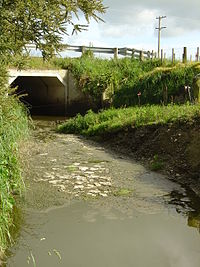
Photo from wikipedia
Abstract Effects of mitigation measures in agriculture on abating eutrophication are difficult to evaluate by assessments of catchment monitoring data. Estimates of improved water quality by specific agricultural Best Management… Click to show full abstract
Abstract Effects of mitigation measures in agriculture on abating eutrophication are difficult to evaluate by assessments of catchment monitoring data. Estimates of improved water quality by specific agricultural Best Management Practices (BMPs) are therefore often dependent on simulation modeling. A main objective was thus to assess the probable reductions in total phosphorus (TP) loading achieved by implemented agricultural mitigation measures. The case-study site was a catchment in southeastern Norway. Simulation modeling was conducted by use of The Soil and Water Assessment Tool (SWAT). The aim of this present study was to understand the model uncertainty associated both with calibration/validation (baseline) and TP loading scenarios based on BMP. The modeled decrease in TP loading by the set of implemented BMPs was assessed by comparing simulated baseline output with output where the set of abatement actions were removed. The model was set up for the years 2006–2010 and calibrated against observed monitoring data, including daily discharge, sediment- and TP fluxes. Model simulations were performed including and excluding the implemented set of mitigation measures. The simulated set of mitigation measures include decrease in amount of phosphorus fertilization, establishment of vegetated buffer strips along streams and constructed wetlands in the water courses, no autumn tilling and removal of point TP sources from scattered dwellings. Model calibration and uncertainty estimation are performed using an algorithm for Sequential Uncertainty Fitting (SUFI2; ver. 2). Probabilistic risk for given magnitudes of increased TP loading if existing BMPs were not implemented was assessed. Using this novel approach it was possible to state, with a 80th percentile confidence level, that the average annual TP loading would have been about 26% higher if no mitigation measures were implemented in the catchment. This was possible to assess even though the difference between baseline and BMP scenario was not significant.
Journal Title: CATENA
Year Published: 2019
Link to full text (if available)
Share on Social Media: Sign Up to like & get
recommendations!